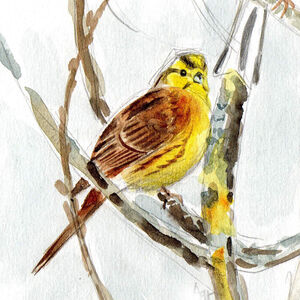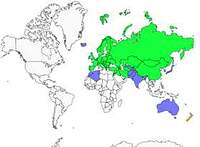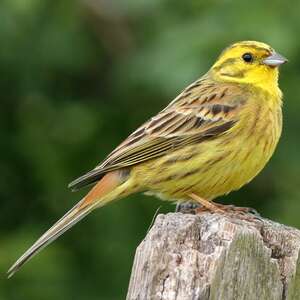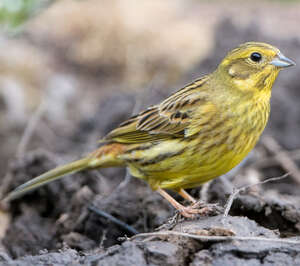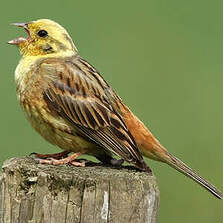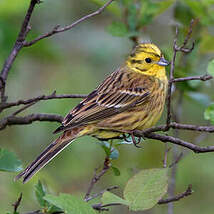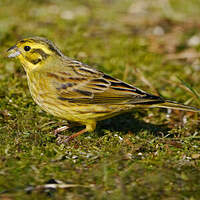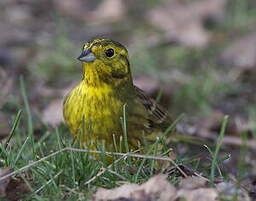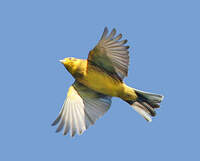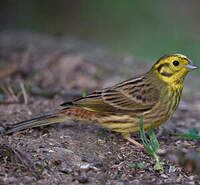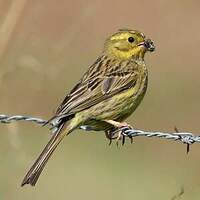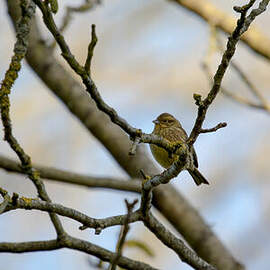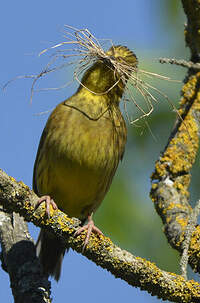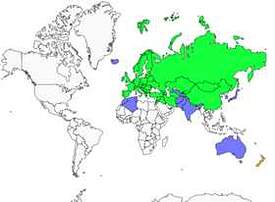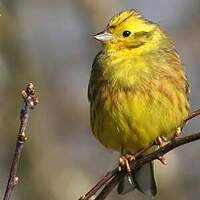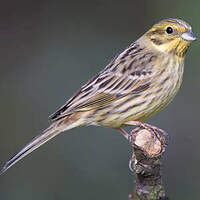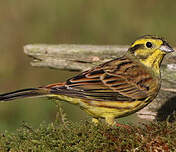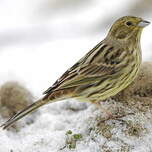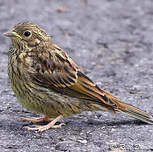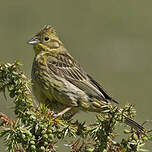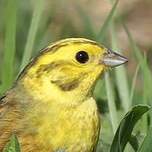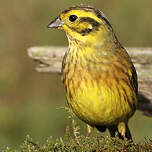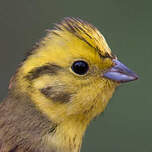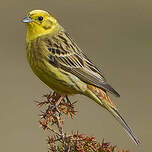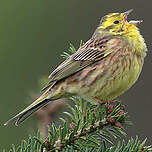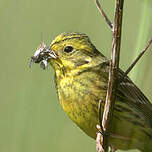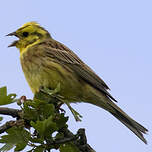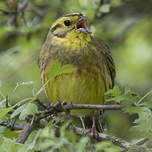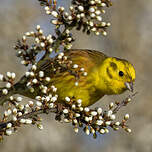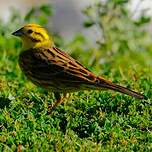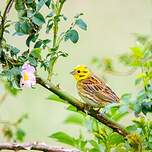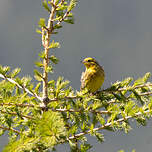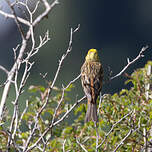Yellowhammer
Emberiza citrinella - Bruant jaune
Identification
The Yellowhammer is a rather large bird (16-17 cm in length with a weight of 25-30 g), quite slender with a large tail. Sexual dimorphism is clear. The adult male in breeding plumage is easy to recognize by the yellow colour which dominates its plumage and its large size distinguishes it, for example, from the Common Chaffincheese which superficially resembles it but is much smaller. The head is lemon yellow with olive-brown bands, a band on the side of the cap, a post-ocular and a last one underlining the auricular covers. Finally, a slight moustache trait can be noted which disappears completely with wear. The beak is bicoloured, dark grey on the upper part and steel blue on the other. The upperparts have a beige background colour and are clearly streaked with blackish brown. It is especially necessary to note the rump and the coverts of the tail, reddish brown to light brown, colour which is observed in all plumages and which constitutes the best distinctive specific character. Unfortunately, this last one is hardly visible when the bird is perched as hidden by the tip of the wings. A very slight reddish or fawn colour can be noted at the level of the shoulder blades and the upper wing covers. The primary remiges are edged with yellow. The tail is brown with very white outer rectrices, well visible in flight. The lowerparts are entirely yellow. An irregular pectoral band, olive at the top, red-brown at the bottom, bars the chest. It is more or less clear depending on the individuals and the state of the plumage. The flanks are clearly streaked with reddish brown, the belly much less or not at all. The legs are light, pinkish to brownish or even yellowish. The nuptial male becomes very yellow with the wear of the plumage, in particular at the level of the head where the dark marks tend to fade.The adult female resembles the male, but is less yellow, although older females may be similar to the males in plumage. She is also more striped underneath. The common feature is the reddish-brown rump and upper tail-coverts, although this latter criterion is less distinct in her. This last criterion allows for it to be definitely distinguished from the female of the Otropis barbata, which is otherwise quite similar but even less yellow. The juvenile resembles a female, but is more dull and more striped underneath. The stripes are thicker and more diffused on a yellowish background. The pale patch that the female already has is more visible against the dark background of the ear-coverts. The legs are pink and the bill is not clearly two-toned. I remind that confusion is possible with the Otropis barbata, but the latter never has the reddish rump.
Subspecific information 3 subspecies
- Emberiza citrinella citrinella (se England and w continental Europe to nw Russia and Poland south to the Balkans)
- Emberiza citrinella caliginosa (w and n British Isles)
- Emberiza citrinella erythrogenys (e Europe to sc Siberia)
Foreign names
- Bruant jaune,
- Escribano cerillo,
- escrevedeira-amarela,
- Goldammer,
- citromsármány,
- Geelgors,
- Zigolo giallo,
- gulsparv,
- Gulspurv,
- strnádka obyčajná,
- strnad obecný,
- Gulspurv,
- keltasirkku,
- verderola,
- Gultittlingur,
- trznadel (zwyczajny),
- dzeltenā stērste,
- rumeni strnad,
- Обыкновенная овсянка,
- キアオジ,
- 黄鹀,
- gulsparv,
- 黃鵐,
Voice song and call
The typical call is a quite typical djiih which is slightly impure. Also heard are djirp rolled or even doubled as djirep. In flight it will produce a short zit or zip, or even a tsirp. Therefore a rather large range of calls. The song, monotonous, is a fast and mechanical succession of 6 to 8 dih followed by a stretched and impure ziiiiih note, often with a lower tone. But the variations are numerous, either in the timbre, the rhythm or the tone. It is the association of both parts which is typical. Sometimes the first part accelerates to the point of resembling the phrase of the Yellowhammer. It could lead to confusion without the final motif, which is sometimes omitted.
Habitat
The Yellowhammer is a bird of open and semi-open grasslands and mid-mountain areas, with an optimum between 600 and 900 m altitude.
Behaviour character trait
The Yellowhammer is gregarious outside of the breeding season, a characteristic of the family. It usually forms small groups that search for food on the ground in fields and flies to the nearest bushes at the slightest alert.
It seeks out seeds, cereals and other rapeseed which have escaped modern mechanized harvesting. It often does so in company with other granivores such as finches. On the ground, it moves by hopping. In contrast, in the springtime it becomes territorial, with mating pairs sharing favourable nesting areas. The males then sing out of sight on top of a bush in order to be seen and heard by their fellow kind. In doing so, they defend their territory. This bunting is a partial migrant. In the winter, one simply notices a movement of the population to the south, with the birds of the north having the most to move in order to evade the winter rigours. But none reach Africa. The birds spend the night in roosts in woodlands, often in the company of other buntings, prey in particular, and fringillids, finches, greenfinches and siskins.Flight
The Yellowhammer has a direct and mostly not very high flight. Like all members of the family, it alternates sequences of energetic flappings and pauses with closed wings, as also done by finches, but the flight of yellowhammers is less undulating. The migratory movements take place during the day, in small loosely grouped and at low altitude.
Dietfeeding habits
The diet is mixed, but the basic diet is granivorous. This one prevails the majority of the time. The beak is adapted to this diet.
All kinds of seeds are consumed. Obviously, as a way of convenience, all cereal seeds abandoned on the ground after harvest, in particular. But also the seeds of wild plants, especially those still standing when the snow covers the ground (nettles, patience, swine, etc.). In the breeding season, especially for the feeding of young birds who need a nutritious food for their growth, the diet becomes insectivorous. Long is the list of potential prey that come not only from insects, which are the majority, but also from other invertebrates such as spiders, centipedes, earthworms and even small molluscs. In the majority of cases, the captures are on the ground.Reproduction nesting
Breeding season starts relatively late, late April-early May in temperate European plains, later in higher altitudes and more northern latitudes, continuing until early summer, which allows most pairs to have two successive nestings.
The nest is built by the female with the male only accompanying her, his role being to defend the territory. It is made out of dry grass, blades, leaves and some moss, well hidden under a grassy tuft, always very close to the ground and often near or in the shelter of a thorny bush or bramble. It is quite a big nest, with a lined interior composed of delicate vegetal elements, and is very neat. The laying consists of 3 to 5 pinkish white eggs, speckled with purple-brown. As it is often the case with yellowhammers, the shell is drawn with irregular lines of the same colour. The female is in charge of incubation for 12-14 days and stays with the young for some time after they've hatched, the male being responsible for providing food for the family. The young ones fly away at 12-13 days old. The reproductive success can be as low as 40% because of the many causes of failure. Predation by well-known predators such as crows and magpies seems to be a major cause of failure, but since the context is often agricultural, many nests are destroyed by connected agricultural activities, mechanical or chemical treatments of crop fields, circulation of agricultural machines, trampling by livestock, etc., all non-natural causes influencing the species' demographics in a negative way.Geographic range
In the breeding season, the Yellowhammer is a bird of middle latitudes that thrives in a temperate climate. Whilst they can travel quite high in altitude and latitude, as far north as Scandinavia, they are reluctant to travel south. The Mediterranean climate, which is too hot for them, is not suitable. They can be found continuously from the Atlantic coast (British Isles, Breton tip and Galicia in Spain) west to Central Siberia and northwest Mongolia to the east. It passes the Polar Circle in the north, but is more localized. All of Europe is occupied, except for most of Spain and the Mediterranean coast. It is absent from Asia Minor and the Caspian region, except for isolated areas in the Caucasus. In winter, the birds from the northern part of its range leave for the south. The most northern, and thus most migratory, travel as far south as the Mediterranean, Asia Minor, the Middle East, the Caspian region to Iran and Central Asia. Those in temperate regions are sedentary or erratic.
Threats - protection
IUCN conservation status
concern
in the Wild
threatened
evaluated
The Yellowhammer remains a common bird and as such is not classified as an endangered species at the European level, but for how long? Systematic population surveys conducted in the last decades indicate that the species is in sharp decline. For example, the French STOC survey shows a pronounced decline of -45% in the last 10 years and -59% in the last 30 years. Given the recent evolution of agricultural practices and the decrease in diversity that it brings in all areas, one can only be pessimistic about the future of this species in an agricultural environment, unless there is a major societal change.
Sources of information
- IOC World Bird List (v14.2), Gill, F and D Donsker (Eds). 2024-04-18.
- Atlas des oiseaux de France métropolitaine. Nidification et présence hivernale. , Issa Nidal et Muller Y
- Les passereaux d'Europe, tome 2, P. Géroudet, M. Cuisin
- HBW Alive,
- xeno-canto, Sharing bird sounds from around the world,
Other sources of interest
 Specification sheet created on
15/07/2023 by Jean François
Specification sheet created on
15/07/2023 by Jean FrançoisTranslation by AI Oiseaux.net
© 1996-2025 Oiseaux.net
- Accipitriformes
- Aegotheliformes
- Anseriformes
- Apodiformes
- Apterygiformes
- Bucerotiformes
- Caprimulgiformes
- Cariamiformes
- Casuariiformes
- Charadriiformes
- Ciconiiformes
- Coliiformes
- Columbiformes
- Coraciiformes
- Cuculiformes
- Eurypygiformes
- Falconiformes
- Galliformes
- Gaviiformes
- Gruiformes
- Leptosomiformes
- Mesitornithiformes
- Musophagiformes
- Nyctibiiformes
- Opisthocomiformes
- Otidiformes
- Passeriformes
- Pelecaniformes
- Phaethontiformes
- Phoenicopteriformes
- Piciformes
- Podargiformes
- Podicipediformes
- Procellariiformes
- Psittaciformes
- Pterocliformes
- Rheiformes
- Sphenisciformes
- Steatornithiformes
- Strigiformes
- Struthioniformes
- Suliformes
- Tinamiformes
- Trogoniformes

